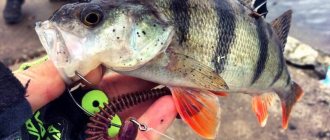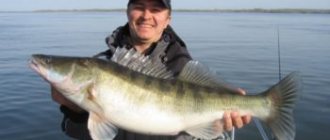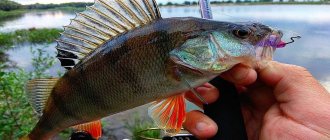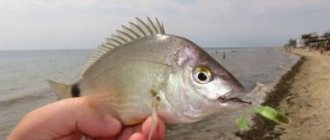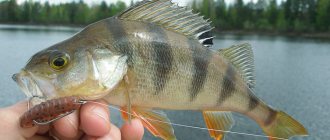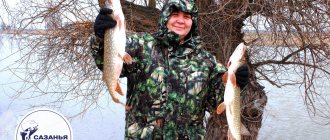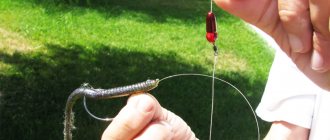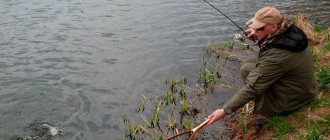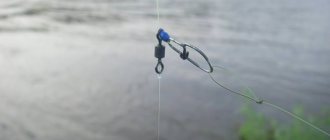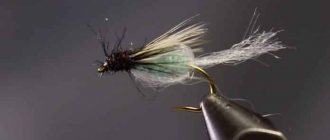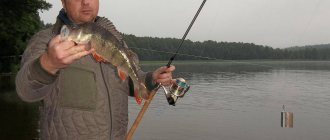The role of the leash in feeder installation
Let's start with the concept - what is a leader line and why is it needed for feeder fishing. The leader line is one of the most important aspects in feeder fishing; by adjusting the main diameter of the leader, you can target large and small underwater creatures.
When catching passive fish, reducing the diameter of the feeder tackle leads to an increase in bites and catches. The length of the leash can also increase the percentage of bites, but there is no clear answer as to which leash catches more.
The length of the leash on the feeder is selected individually for each fish and for a specific body of water in its own way. This also includes the temperature of the water, if the water is cold, more often this means that the fish is passive and requires a delicate approach, or rather, reducing the diameter of the leash, as well as the thickness and size of the hook. This knowledge and manipulations will raise your level of training on the pond, but this is theory, without practice there is nowhere in our business.
What is a leash for?
A fishing leash is usually called a small (40-60 cm) garter attached to a fishing line to which a fishing hook is attached. This is done to camouflage the main line in the water, as well as to prevent the main line from breaking in the event of a snag from which it is impossible to free oneself. Therefore, for the leash, a fishing line is chosen that is slightly thinner than the main one. For example, if when fishing with a float rod, a main line with a diameter of 0.15 - 0.2 mm is used, then the leashes are installed approximately 0.03 - 0.05 mm thinner.
Of course, the use of a leash (lead) is not necessary, but still advisable. It is better if the leash line is close in color to the color of the bottom or aquatic vegetation in the fishing area. When catching small fish - gudgeon, roach, ruffe, you can do without a leash, and tie the hook directly to the main fishing line, as many young and novice fishermen often do. If leashes are used in bottom gear, then it is recommended to make them from fishing lines of different colors - this makes it easier to untangle them if they are intertwined with each other, and also to control the “catchability” of various baits.
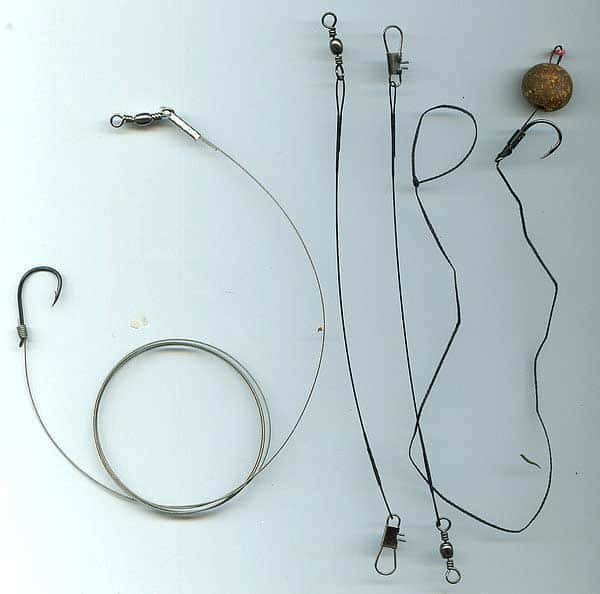
How to knit leashes for fishing. Leash with one and two hooks (Video)
Line selection

There are main and leader lines; the main line is used as an alternative to braid when fishing for large fish at short distances. And also its use will be relevant in spring or winter in negative temperatures. The leader line serves as the penultimate link between the angler and the fish, so the quality of the material is very important if you are serious about it.
The fishing line must meet its criteria, namely: tensile strength, wear resistance (shelf life, storage conditions), accuracy of the declared diameter, uniformity of the material, rigidity and permissible stretch, resistance to knots and the load on them and price. This can also include color, but I always try to take one tone, natural. I am skeptical about the red and green options and avoid them.
Nuances of choice in the store
Arriving at the store, your eyes widen, but you need to choose good material. I recommend that you immediately discard the cheapest fishing lines for yourself, since it is better not to skimp on leashes for feeder fishing. Below I will give my rating of leader lines that are worth paying attention to. Check with the seller about the freshness of the goods; you shouldn’t take stale fishing line, it’s money down the drain. If you take foreign brands, then add delivery from another country to its shelf life. For example, goods from England most likely do not ship faster than one month.
Diameter
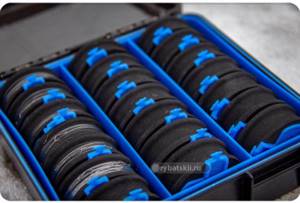
Every novice feeder angler's kit should contain fishing lines of all diameters, at least one reel. Specific diameters range from 0.08 to 0.18 mm . Thin diameters are useful for catching passive fish in winter, early spring and late autumn, and in still waters. On the river, during the period of bream fishing, the leash should be enlarged to at least 0.12 mm, but everything has an exception, so we take all diameters.
Breaking load
Look at the breaking load, it should be relevant to the diameter. It should not be overestimated or underestimated. Why shouldn't you buy cheap monofilament threads? - Quality. Manufacturers write invalid information. Having bought a monk for 80 rubles, the diameter will be stated on the label as 0.09, but in fact, at best, it will be 0.12. This has already been tested by experts in feeder fishing.
Gear selection
What do you need to consider to make the right fishing rod leader? These should include factors such as the quality of the fishing line, the correct choice of hooks and the required leash length.
It is necessary to consider each point in more detail.
fishing line
The most important part of a float rod. It is well known to everyone that almost all fish are very shy and it is often quite difficult to catch them. She immediately swims away if she notices a thread with bait. In order for fishing to bring good results and not have a long and tedious wait for a bite, you need to be very responsible when choosing a fishing line. It must be thin , and the color should preferably match the water and the bottom of the reservoir in which fishing is carried out.
Hook
This element for fishing is also a fairly important part of the float rod. The size of the hook and its strength are of great importance. Sometimes you come across overheated hooks that break during the first load, so you should purchase them in specialized stores. You can determine for yourself how strong the hook is. To do this, you need to use a thick fishing line to secure it to the eye and pull the forend with a steelyard. The hook bends, after which it should not return to its original shape. This is what determines its initial strength.
The size of the hook depends on the fishing line - the thicker it is, the larger the hook should be. However, experts say that a small hook is also good for catching large fish. It is highly undesirable to use a thick hook with a thin fishing line; it can only cause harm.
Leash length
When choosing the length of the leash for a float rod, there is no need to rush. It should be noted that although a long leash allows you to scare away the fish less, at the same time, such a length reduces the information content of the bite and the process becomes uncontrollable.
The length of the leash needs to be selected correctly, sometimes experimentally, taking into account the conditions under which fishing will take place. General recommendations are as follows:
- the optimal length for a Bolognese fishing rod and match tackle should be 2540 cm;
- for catching roach, the length of the leash ranges from 20 to 25 cm;
- for catching bleak or bream it is 1015 cm.
Length when fishing for cautious fish
In the Kaluga region there are reservoirs where fish are reluctant to feed. You have to adapt to it. I can’t say that about our river; the fish there almost always show interest in the bait. I will name two reservoirs where I have to apply my developments - this is the Yachenskoye reservoir, it is located in the city of Kaluga, and the Andreevsky quarry, which is located twenty kilometers from the city. In terms of their structure, all sand pits are interesting, there are great depths, there is nothing to catch on at the bottom and the presence of a large concentration of fish. All that remains is to catch her.
The first thing I do, if there is a fish at the point, but does not touch the bait or touches it, but there is no confident bite, I start trying to cheer up the underwater inhabitants. I do this by adding concentrates and pureeing the live component.
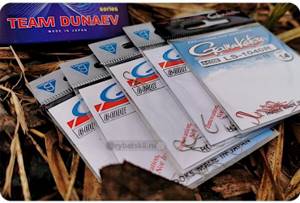
If the actions do not bring results, I proceed to selecting the optimal length of the feeder leash and hook size. At the reservoir, a meter-long leash with a thin hook for the feeder often helps out; 2-3 bloodworm larvae are saved as bait.
Often, capricious fish have a negative attitude towards increasing the diameter of the leader line.
These manipulations will most likely provoke the fish to bite, but if this does not happen, then most likely the algorithm was performed incorrectly or there is no fish at the point.
How to knit leashes on a feeder
Making leashes in advance is a good idea. In my arsenal I have a leash holder from the Preston company; it is a useful unit where I store my set of leashes. I have already reviewed the leash, so I won’t talk about it now. I will say this, a leash is needed and it doesn’t matter what company it comes from. Sometimes the weather is not conducive to fishing and you have to sit at home to keep your hands busy; I knit and make leashes for the feeder in advance.
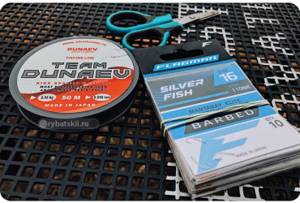
There are many places in my region where I already know what length of leash is relevant and what kind of hook will be in the future. Therefore, all that remains is to find time and knit. A useful activity that develops fine motor skills and helps you concentrate on little things. If you don’t know what will work on a certain body of water, then I recommend knitting something universal. The most successful length for a feeder on a current, in my opinion, is a meter leash. In still water, a length of 30-60 centimeters is most likely suitable.
Sometimes I use such a useful thing as an “extension cord”. This is a section of a thicker piece of fishing line that helps to lengthen the leaders by minimizing the loss of precious material.
For example, you have leashes 60 centimeters long, but now one meter is relevant. We take a 0.12 piece of fishing line 40 centimeters long and insert it in a loop-to-loop manner. I use this trick only when catching bleak in competitions.
The extender is also made from fluorocarbon, which is a type of fishing line. Fluorocarbon is an artificially produced polymer composition that contains a significant percentage of carbon and fluorine, which gives the fishing line significant rigidity. And also he is invisible in the water, as fishermen say. To be honest, I hardly use fluorocarbon, so I have minimal information about its use. For me, it is more relevant when catching a predator.
I tie the hooks to the leader line with a clinch, also called an improved clinch. It is problematic to explain in words, so it would be more relevant to watch the video and repeat, after a couple of trial nodes everything will work out. At the end of the leash we always make a loop that does not tighten. The loop should not be too large, but not too small, so it will be more convenient to change leashes when fishing at a pace. With a certain amount of practice, you will develop a certain standard.
The leash is a noose. What it is?
There are several garrote leashes available in my store. They are all 2 in one. It is enough to simply connect the noose ring and a regular collar with a carabiner - and this is a ready-made leash! This is very convenient, because constant use of a noose is not recommended. Let's say that you go for a walk with a leash on a regular collar, and to practice any skills, you remove the collar and use the leash as a noose. No extra accessories needed! All snare leashes in my store are made of satin cord with 8 strands + base. They have no stretch. Reliably stitched and taped. The thickness of this leash is 1.2-1.5 cm, which allows you to protect your beloved pet from possible injuries. All leashes are made for dogs of medium and large breeds. There are long leashes for practicing “nippers” and short ones for practicing control in crowded places.
What is a leash-noose?
A noose or leash-controller for dogs - as a ring leash is often called. Its design is such that when the leash is pulled, the loop compresses the dog’s neck, preventing it from pulling on the controller, and when the tension is released, the loop lowers. What is a dog leash in terms of design? This can be either a set of collar and leash connected by an inconspicuous carabiner, or a one-piece leash with a sliding collar at the end. On the other hand, the controller noose is equipped with a loop for the owner's hand.
This kind of leash-noose is used both for the purposes of training and behavior correction, and for everyday wear in dogs with a narrow muzzle (collie, sharpei, samoyed...), in which the usual non-tightening version of the equipment simply slides off the neck over the head. However, I do not recommend dressing small breeds of dogs or small puppies. You can simply injure the spine, and the dog can also suffer from simple suffocation. Please note that a noose, like a strict collar, cannot be used constantly, but only when practicing basic behavioral skills, teaching commands and training them.
It is permissible to use it only as an additional means of control, but not as a substitute for regular exercises with the dog to practice obedience. It is advisable that the instructor demonstrate to the owner how to properly use such collars. Also, under no circumstances should you put a choke collar on a dog sitting on a chain - it can suffocate or seriously injure itself!
Welcome!
Two leashes per feeder
Some amateur fishermen put two leashes on the feeder. This option has nothing to do with feeder fishing; it relates more to the classic donkey. For me, a feeder is a tackle with one feeder and one hook. There are no other options. If you think that the number of hooks can increase the catch, then you are mistaken . Delicate tackle can many times catch any other fishing method, although much depends on the angler himself. But this is just my personal opinion.
